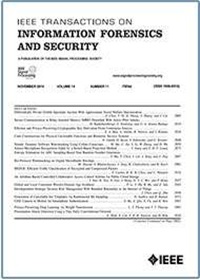Deep Prediction and Efficient 3D Mapping of Color Images for Reversible Data Hiding
IF 8
1区 计算机科学
Q1 COMPUTER SCIENCE, THEORY & METHODS
IEEE Transactions on Information Forensics and Security
Pub Date : 2025-02-24
DOI:10.1109/TIFS.2025.3544956
引用次数: 0
Abstract
In the reversible data hiding (RDH) community, both prediction and mapping strategies are vital for reducing distortion. With high prediction performance, small prediction errors can be generated to reduce the embedding distortion. Besides, the efficient mapping strategy can improve the practicality. In this paper, we propose a new RDH method for color images by using convolution neural networks (CNNs) for prediction and an efficient 3D mapping strategy for embedding. At first, each color image is elaborately divided into three isolated image sets so that the proposed deep prediction network (DPN) can exploit more neighboring pixels in the current channel and the correlation between three channels. Then, an efficient 3D mapping strategy is luminously designed by using the symmetry of the 3D prediction error histogram (PEH). The symmetry of 3D PEH has been analyzed in statistical and experimental ways. Based on the proposed deep prediction network and efficient 3D mapping strategy (DPEM), we construct an efficient RDH method for color images. The performance of the proposed DPN is evaluated by comparing it with several predictors on different image datasets. The embedding performance has been demonstrated by hiding information in color images, e.g., the average PSNR value of the Kodak dataset is 63.63 dB with an embedding capacity of 50,000 bits. Furthermore, the experimental results on the ImageNet and PASCAL VOC2012 datasets have shown the proposed RDH method is superior to several state-of-the-art RDH methods. With the introduction of deep learning, the development of the RDH method for color images can be promoted.用于可逆数据隐藏的彩色图像的深度预测和高效三维映射
在可逆数据隐藏(RDH)领域,预测和映射策略都是减少失真的关键。预测性能高,预测误差小,减少了嵌入失真。此外,有效的映射策略提高了系统的实用性。在本文中,我们提出了一种新的彩色图像RDH方法,该方法使用卷积神经网络(cnn)进行预测,并使用有效的3D映射策略进行嵌入。首先,将每个彩色图像精心划分为三个独立的图像集,使所提出的深度预测网络(DPN)可以利用当前通道中更多的相邻像素和三个通道之间的相关性。然后,利用三维预测误差直方图(PEH)的对称性,设计了一种高效的三维映射策略。用统计和实验的方法分析了三维PEH的对称性。基于所提出的深度预测网络和高效三维映射策略(DPEM),构建了一种高效的彩色图像RDH方法。通过将DPN与不同图像数据集上的几个预测器进行比较,对所提出的DPN的性能进行了评估。通过将信息隐藏在彩色图像中,证明了嵌入性能,例如,柯达数据集的平均PSNR值为63.63 dB,嵌入容量为50,000位。此外,在ImageNet和PASCAL VOC2012数据集上的实验结果表明,本文提出的RDH方法优于几种最先进的RDH方法。随着深度学习的引入,可以促进彩色图像RDH方法的发展。
本文章由计算机程序翻译,如有差异,请以英文原文为准。
求助全文
约1分钟内获得全文
求助全文
来源期刊

IEEE Transactions on Information Forensics and Security
工程技术-工程:电子与电气
CiteScore
14.40
自引率
7.40%
发文量
234
审稿时长
6.5 months
期刊介绍:
The IEEE Transactions on Information Forensics and Security covers the sciences, technologies, and applications relating to information forensics, information security, biometrics, surveillance and systems applications that incorporate these features
 求助内容:
求助内容: 应助结果提醒方式:
应助结果提醒方式:


